NASA scientists haven’t given up hope in their search for the missing Contour spacecraft, which disappeared shortly after it was supposed to fire its thrusters on Thursday. A telescope captured an image of two separate objects, moving in the direction Contour was supposed to be headed, leading to speculation that the spacecraft broke in two, but this hasn’t been confirmed yet. Had it worked properly, Contour would now be on its way to meet up with two comets to take high resolution photos of their nuclei.
Cassini Camera Working Fine Again
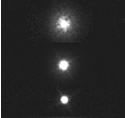
Image credit: NASA
Controllers for the Cassini spacecraft received some good news last week when the latest set of test images came through showing no distortion in its camera system. They became worried last year when haze appeared on the camera after it was heated briefly in a maintenance operation – the haze diffused 70% of the light reaching the camera. Controllers slowly heated and cooled the spacecraft several times, and now the distortion is down to 5%. Cassini will begin orbiting Saturn on July 1, 2004 and it will deliver the piggybacked Huygens probe into the atmosphere of Titan.
Now within two years of reaching Saturn, NASA’s Cassini spacecraft took test images of a star last week that reveal successful results from an extended warming treatment to remove haze that collected on a camera lens last year.
The quality of the new images is virtually the same as star images taken before the haze appeared. In the most recent treatment, the camera had been warmed to 4 degrees Celsius (39 degrees Fahrenheit) for four weeks ending July 9. Four previous treatments at that temperature for varying lengths of time had already removed most of the haze. The camera usually operates at minus 90 C (minus 130 F), one of the temperatures at which test images were taken on July 9 of the star Spica.
“We’re happy with what we’re seeing now,” said Robert Mitchell, Cassini program manager at NASA’s Jet Propulsion Laboratory, Pasadena, Calif. The team will decide in coming weeks whether to proceed with another warming treatment later this year.
Cassini’s narrow-angle camera worked flawlessly for several months before and after a December 2000 flyby of Jupiter. Haze appeared when the camera cooled back to its usual operating temperature after a routine-maintenance heating to 30 C (86F) in mid-2001. Lens hazing from engine exhaust or other sources is always a possibility on interplanetary spacecraft. Planners designed heaters for Cassini’s cameras to cope with just such a situation.
Before treatment, the haze diffused about 70 percent of light coming from a star, by one method of quantifying the problem. Now, the comparable diffusion is about 5 percent, Cassini engineers Charles Avis and Vance Haemmerle report. That’s within one percent of what was seen in images from before the hazing occurred, possibly within the range of statistical noise in the analysis. Comparison images are posted at http://www.jpl.nasa.gov/images/cassinicamera_caption.html.
Additional information about Cassini-Huygens is online at http://saturn.jpl.nasa.gov.
Cassini will begin orbiting Saturn on July 1, 2004, and release its piggybacked Huygens probe about six months later for descent through the thick atmosphere of the moon Titan. Cassini-Huygens is a cooperative mission of NASA, the European Space Agency and the Italian Space Agency. JPL, a division of the California Institute of Technology in Pasadena, manages the mission for NASA’s Office of Space Science, Washington, D.C.
Original Source: NASA/JPL News Release
ESA Agrees to Begin Venus Express
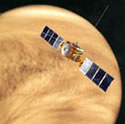
Image credit: ESA
The members of the European Space Agency agreed to start work on Venus Express, which will reuse the Mars Express spacecraft design. It will also reuse several instruments from both Mars Express and Rosetta to peer through our twin planet Venus’ thick clouds. One country, Italy, still has until October 2002 to confirm its participation in the payload. If all goes well, the spacecraft will launch in 2005.
On 11 July 2002, Europe took a step closer to Venus. The ESA Science Programme Committee agreed unanimously to start work on Venus Express. Venus Express will reuse the Mars Express spacecraft design and needs to be ready for launch in 2005.
The mission’s fate is not yet final because one nation, Italy, has still to confirm its participation in the payload. Italy has been given until 15 October 2002 to provide its final commitment.
The idea behind Venus Express began in 2001 when ESA issued a call for ideas to reuse the Mars Express spacecraft design for a quick, low-cost mission. Among the constraints were that the new mission had to use the industrial teams already in place for Mars Express and that meant double-quick development. Despite the constraints, a large number of good ideas came in from scientists around Europe. Venus Express was eventually selected because of its great scientific value. Venus is not well explored and an excellent group of instruments were easily available in Europe. These instruments had been developed as back-ups for either ESA’s Mars Express spacecraft or ESA’s comet-chaser mission, Rosetta. The instrument suite will be able to look at the planetary environment from surface to outermost atmosphere.
In November 2001, ministers from ESA’s Member States restricted the ESA Science Directorate’s budget thereby reducing the chance of survival of the Venus Express proposal.
Nevertheless, against the odds, Venus Express appeared among the missions proposed in the restructured programme presented to the Science Programme Committee in May 2002. However, at the last moment, the Director of Science withdrew it from consideration because he felt that the Member States and the scientists were not fully able to commit to providing funds and instruments within the tight schedule required.
The Director of Science, Prof. David Southwood remembers, “I did not like withdrawing it from our plans but it was better not to start at all than to have to stop badly later.”
In June 2002, the ESA Council heard Southwood’s report. The Council Chairman, Alain Bensoussan of France, strongly urged a re-evaluation of the viability of the Venus Express. On 11 July 2002, the SPC decided the prospects were now sound enough to commence work to meet a launch date in November 2005 that is fixed by the motion of the heavens.
“The Venus Express mission has now taken a big step towards realisation. However, there is much work to do and we had to demand everyone has to be ready if it is to fly in time,” Southwood says, adding, “I’m now glad to see that the Cosmic Vision programme moves closer to its original shape. If we can get Venus Express confirmed in the autumn, ESA will be the only space agency in the world with current plans to visit each planet in the inner Solar System.”
Original Source: ESA News Release
CONTOUR Comet Mission Launches
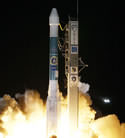
Image credit: NASA
NASA’s Comet Nucleus Tour (CONTOUR) spacecraft launched successfully on board a Boeing Delta II rocket this week. Designed by the John Hopkins University Applied Physics Laboratory, the 970 kilogram spacecraft was placed into an elliptical orbit 63 minutes after launch. CONTOUR will orbit Earth until August 15, when it will fire its main engine and begin chasing Comets Encke and Schwassmann-Wachmann 3. If all goes as planned, the spacecraft will get as close as 100km from each comet’s nucleus.
NASA?s Comet Nucleus Tour (CONTOUR) spacecraft ? set to provide the closest look yet at the ?heart? of a comet?successfully launched today at 2:47 a.m. EDT aboard a Boeing Delta II rocket from Cape Canaveral Air Force Station, Fla.
Designed and built by The Johns Hopkins University Applied Physics Laboratory (APL) in Laurel, Md., the 2,138-pound (970-kilogram) spacecraft was placed into an elliptical Earth orbit 63 minutes after launch. About 19 minutes later the mission operations team at APL acquired a signal from the spacecraft through the Deep Space Network antenna station in Goldstone, Calif., and by 5:45 a.m. EDT Mission Director Dr. Robert W. Farquhar of the Applied Physics Lab confirmed the craft was operating normally and ready to carry out its early orbit maneuvers.
?CONTOUR?s launch was a spectacular start to an important project,? says Dr. Stamatios M. Krimigis, head of the APL Space Department. ?CONTOUR is next in the growing lineup of missions to explore small planetary bodies ? such as comets and asteroids ? and we expect it will add much to what little we know about these ancient samples of the solar system?s original materials.?
CONTOUR will orbit Earth until Aug. 15, when it?s scheduled to fire its main engine and enter a comet-chasing orbit around the sun. The mission?s flexible four-year plan includes encounters with comets Encke (Nov. 12, 2003) and Schwassmann-Wachmann 3 (June 19, 2006), though it can add an encounter with a ?new? and scientifically valuable comet from the outer solar system, should one be discovered in time for CONTOUR to fly past it. CONTOUR?s four scientific instruments will take detailed pictures and measure the chemical makeup of each comet?s nucleus ? a chunk of ice and rock ? while analyzing the surrounding gas and dust.
The 8-sided solar-powered craft will fly as close as 62 miles (100 kilometers) from each nucleus, protected by a 10-inch-thick, layered dust shield of heavy Nextel and Kevlar fabric. Scientists expect the data to reveal the differences between comet nuclei and answer questions about the role comets had in shaping the Earth and other planets.
?We?re looking forward to a fantastic mission,? says APL?s Edward L. Reynolds, who at launch assumed the role of CONTOUR project manager from Mary C. Chiu, who is retiring from the Applied Physics Laboratory. ?From mission design and operations at APL, to the navigation group at NASA?s Jet Propulsion Laboratory, to the science effort headed by Cornell University, this team includes the talent and expertise needed to capture and deliver the best data yet on a comet?s nucleus.?
The $159 million CONTOUR is the sixth mission in NASA?s Discovery Program of lower cost, scientifically focused exploration projects. APL manages the mission, built the spacecraft and its two cameras, and will operate CONTOUR during flight. NASA?s Goddard Space Flight Center, Greenbelt, Md., provided CONTOUR?s neutral gas/ion mass spectrometer and von Hoerner & Sulger, GmbH, Schwetzingen, Germany, built the dust analyzer. NASA?s Jet Propulsion Laboratory, Pasadena, Calif., will provide navigation and Deep Space Network (DSN) support. Dr. Joseph Veverka, CONTOUR?s principal investigator from Cornell University, Ithaca, N.Y., leads a science team of co-investigators from universities, industry and government agencies in the U.S. and Europe.
Original Source: NASA News Release
Odyssey Gets More Sensitive
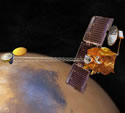
Image credit: NASA
Flight controllers for the Mars Odyssey completed a milestone on Tuesday when they ordered the spacecraft to extend the boom 6.2 metre boom that holds its gamma ray spectrometer sensor head instrument. Even though it hadn’t been deployed yet, the instrument was still able to collect data from Mars’ surface, but this extension will make it much more sensitive. The operation went off without a hitch.
Flight controllers for NASA’s Mars Odyssey spacecraft completed the last major technical milestone today in support of the science mission by unfurling the boom that holds the gamma ray spectrometer sensor head instrument.
Engineers at NASA’s Jet Propulsion Laboratory, Pasadena, Calif., received confirmation from the spacecraft that the 6.2-meter (20-foot) boom was successfully deployed at noon Pacific time.
The gamma sensor head is part of the gamma ray spectrometer suite. It sits at the end of the boom to minimize interference from any gamma rays coming from the spacecraft itself. The two other gamma ray spectrometer instruments, the neutron spectrometer and the high-energy neutron detector, are mounted on the main spacecraft structure.
During the past few months, while the boom was in the stowed position, the instrument suite has provided significant information about the hydrogen abundance on Mars. This allowed scientists to conclude there are large quantities of water ice just below the surface.
“Deploying the boom enhances the sensitivity and accuracy of the gamma ray spectrometer instrument and will improve the accuracy of the hydrogen measurements,” said Dr. William Boynton, principal investigator for Odyssey’s gamma ray spectrometer suite at the University of Arizona, Tucson. Now the instrument will begin measuring many other important elements such as iron, aluminum, potassium, chlorine, thorium, uranium and others.
“Today’s deployment is a continuation of the excellent performance of this flight team. They have done an outstanding job,” said Roger Gibbs, Odyssey’s project manager at JPL. “I look forward to many exciting discoveries to come as we continue our mission.”
JPL manages the 2001 Mars Odyssey mission for NASA’s Office of Space Science, Washington, D.C. Principal investigators at Arizona State University in Tempe, the University of Arizona in Tucson, and NASA’s Johnson Space Center, Houston, operate the science instruments. Additional science investigators are located at the Russian Space Research Institute and Los Alamos National Laboratories, New Mexico. Lockheed Martin Astronautics, Denver, is the prime contractor for the project, and developed and built the orbiter. Mission operations are conducted jointly from Lockheed Martin and from JPL, a division of the California Institute of Technology in Pasadena.
Original Source: NASA/JPL News Release
Cassini’s Feeling Fine
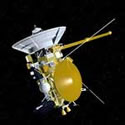
Image credit: NASA
NASA’s Cassini spacecraft continues to hurtle towards its distant rendezvous with the planet Saturn in July 1, 2004. Controllers had the spacecraft take some test photographs of a star, and the camera haze that showed up earlier in the mission appears to be clearing up, as they had hoped it would. The most recent communication with the spacecraft by the Goldstone tracking station last week indicated that Cassini is in excellent health and working normally.
NASA’s Cassini spacecraft continues to fly in good health, speeding toward a July 1, 2004, appointment to begin orbiting Saturn.
Test images of a star taken last week provide strong encouragement that a haze problem noticed on a Cassini camera lens is clearing up as anticipated, said Robert Mitchell, Cassini-Huygens program manager at NASA’s Jet Propulsion Laboratory, Pasadena, Calif.
A 60-day period of warming the spacecraft’s narrow-angle camera to a temperature just above freezing ended May 1. Heaters were built into the camera in anticipation of potential lens hazing; warming treatments have corrected similar hazing on other spacecraft.
Cassini’s narrow-angle camera performed flawlessly for the spacecraft’s December 2000 flyby of Jupiter. The haze first appeared last year, during the cruise between Jupiter and Saturn. Warming the camera to 4 degrees Celsius (39 degrees Fahrenheit) for eight days ending in January 2002 produced improvements, so the same heating was repeated for 60 days.
The new test images of the bright star Spica show that, by one measure, at least 90 percent of the image diffusion originally caused by the lens haze has been corrected. The improvement may actually be greater, because the new images were taken at a temperature warmer than the camera’s optimal operating temperature of about minus 90 C (minus 130 F). Another warming treatment, to last 26 days, began May 9.
About six months after Cassini begins orbiting Saturn, it will release its piggybacked Huygens probe for descent through the thick atmosphere of the moon Titan on Jan. 14, 2005. Cassini-Huygens is a cooperative mission of NASA, the European Space Agency and the Italian Space Agency. JPL, a division of the California Institute of Technology in Pasadena, manages the mission for NASA’s Office of Space Science, Washington, D.C. Additional information about Cassini-Huygens is available online at: http://saturn.jpl.nasa.gov .
Original Source: NASA/JPL News Release
Baikonur Cosmodrome Roof Collapses
The roof of an 80-metre hanger at the Baikonur cosmodrome in Kazakhstan collapsed on Sunday trapping eight workers under the debris. Russian officials believe it’s unlikely any of the workers survived the fall, and have prevented anyone from approaching the hanger for fear the unsteady walls could cave in as well. The collapsed hanger was built in the late 60s for the Soviet space program, and was later used to house a Buran space shuttle.
ESA Plans Another Look at the Moon
The European Space Agency is working on a new spacecraft that will visit the Moon and map its surface in great detail. The SMART-1, due for launch in 2003 will arrive at the Moon and begin a detailed analysis of the surface from different angles, in regular light, infrared and X-ray and then produce a three-dimensional map. Smart-1 will visit the dark southern pole of the Moon for the first time and help investigate areas which have never been touched by the Sun.
Galileo Navigation System is a Go
European transport ministers have approved a plan to develop Galileo, a satellite navigation system. Galileo, which is due to come online in 2008, is expected to cost $3.15 billion US and will consist of 30 satellites deployed in three circular Medium Earth Orbits at an altitude of 23,616 km. Although the system will compete with the US-built Global Positioning System, the designers say the two networks will be compatible and provide redundancy.
Grace Satellites Launched
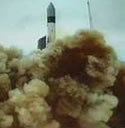
Image credit: NASA
NASA and the German Center for Air and Space Flight successfully launched the Gravity Recovery and Climate Experiment, or “Grace” today. The twin-satellite mission lifted off on Sunday from Russia’s Plesetsk Cosmodrome on board a Rockot launch vehicle. Once in their final orbit, the satellites will separate to a distance of 220km apart, and will begin producing a high-definition gravity map of the Earth’s surface to help scientists understand some of the factors that affect climate change.
NASA and the German Center for Air and Space Flight today successfully launched the Gravity Recovery and Climate Experiment, or “Grace,” mission into Earth orbit at 1:21:27 a.m. Pacific time from Russia’s Plesetsk Cosmodrome. The mission, comprised of identical twin satellites, will precisely measure Earth’s shifting water masses and map their effects on Earth’s gravity field.
The five-year Grace mission-the first launch of NASA’s Earth System Science Pathfinder program-will be a scientific boon to researchers who study Earth with space-based instruments. The monthly gravity maps generated by Grace will be up to 1,000 times more accurate than those currently in use, substantially improving the accuracy of many techniques used by oceanographers, hydrologists, glaciologists, geologists and other scientists to study phenomena that influence climate. These phenomena range from shallow and deep ocean currents, water movement on and beneath Earth’s surface, and the movement and changing mass of ice sheets, to sea-level heights, sea-level rise and changes in the structure of the solid Earth.
Under partly cloudy, cold skies, the Grace twins lifted off on a Russian Rockot launch vehicle. Riding over 1,500,000 newtons (approximately 350,000 pounds) of thrust, the rocket headed northward over the Arctic Ocean and Alaska, then south across the Pacific Ocean and Antarctica before heading north again over Africa and Europe. At 85 minutes, 38 seconds into the mission-or 2:47 a.m. Pacific time-the satellites separated from the launch vehicle’s third stage above Africa into a polar orbit 500 kilometers (311 miles) above Earth.
Ground controllers successfully acquired the spacecraft’s signal from the German Space Operations Center’s ground tracking station in Weilheim, Germany at 2:49 a.m. Pacific time. Initial telemetry reports received by the Grace team show both satellites to be in excellent health.
Following separation, the leading Grace satellite began pulling away from the trailing satellite at a relative speed of about 0.5 meters (1.6 feet) per second. Over the course of the next four days, the satellites will be spaced 220 kilometers (137 miles) apart- a little more than the distance between Los Angeles and San Diego.
As they race around the globe 16 times a day, the satellites will sense minute variations in Earth’s surface mass below and corresponding variations in Earth’s gravitational pull. Regions of slightly stronger gravity will affect the lead satellite first, pulling it slightly away from the trailing satellite. By measuring the constantly changing distance between the two satellites using an extremely sensitive microwave ranging system and combining that data with precise positioning measurements from Global Positioning System instruments, scientists will be able to construct a precise Earth gravity map.
During the next two and a half weeks, basic satellite operations will be established. During a subsequent three-week commissioning phase, Grace’s science instruments and supporting systems will be powered up, evaluated and calibrated. The performance of the Grace system for measuring Earth gravity will then be validated over the following six months. The mission then enters its observational phase, during which routine operational data products will be made available to scientists.
Additional information about the Grace program is available on the Internet at:
http://www.csr.utexas.edu/grace .
Grace is a joint partnership between NASA and the German Center for Air and Space Flight (Deutsches Zentrum fur Luft und Rumfahrt, or DLR). NASA’s Jet Propulsion Laboratory, Pasadena, Calif., manages the U.S. portion of the project for NASA’s Office of Earth Science, Washington. Science data processing, distribution, archiving and product verification are managed under a cooperative arrangement between JPL and the University of Texas’ Austin-based Center for Space Research in the United States and Germany’s Earth Research Center (or GeoForschungsZentrum).
JPL is a division of the California Institute of Technology in Pasadena.
Original Source: NASA/JPL News Release
